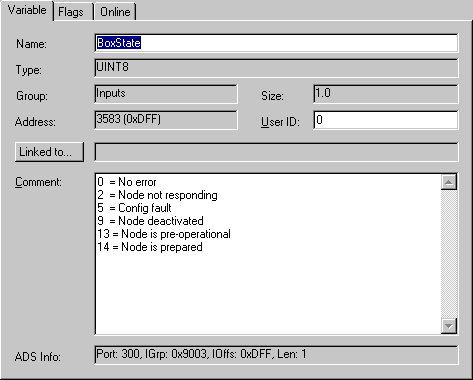CIFx0-CAN: Box Diagnosis
The CANopen fieldbus card CIFx0-CAN has a comprehensive range of diagnostic options for connected network nodes.

For each CANopen fieldbus node there is a box state input variable, which signals the status of the current slave during the running time and can be linked, for example with the PLC.
Node State

DataExchange
This bit indicates whether the node is currently exchanging data. Nodes can only be monitored if their guarding protocol has been activated.
CANopen Emergency Object
Some CANopen status data and up to 5 emergency objects received from a node can be read from any TwinCAT program via ADS and/or signaled to any TwinCAT program. In this case, set ADS parameters as follows:
Port: 300
IndexGroup: 0x5000 + Device-ID
IndexOffset: Hi-Word: Node-ID, Lo-Word: 0x100
Length: 8 - 48
The diagnostic data is structured as follows:
Offset: 0: Nodestatus bits
Bit 7: Node is deactivated
Bit 3: Guarding protocol is active
Bit 2: parameterisation error
Bit 1: Emergency buffer overflow
Bit 0: Mode does not respond
Offset: 1,2: Node type (Index 0x1000)
Offset: 3,4: Profile Number
Offset: 5: Node State
1: Disconnecting
2: Connecting
3: Preparing
4: Prepared
5: Operational
127: Pre-Operational
Offset: 6: Current Error
30: Guarding malfunction
31: Node has changed status
32: Sequence error in guarding protocol
33: No answer from remote frame PDO
34: No answer during a node configuration
35: Incompatible node profile number
36: Incompatible node device type number
37: Unknown SDO response received
38: SDO syntax error
39: Node in STOP mode
Offset: 7: Number of Emergency Messages
Offset: 8-47: Emergency buffer (-> node description)
The data contain the status. The emergency buffer contains the last emergency messages received. The node status bits are collated in the box state diagnostic input.